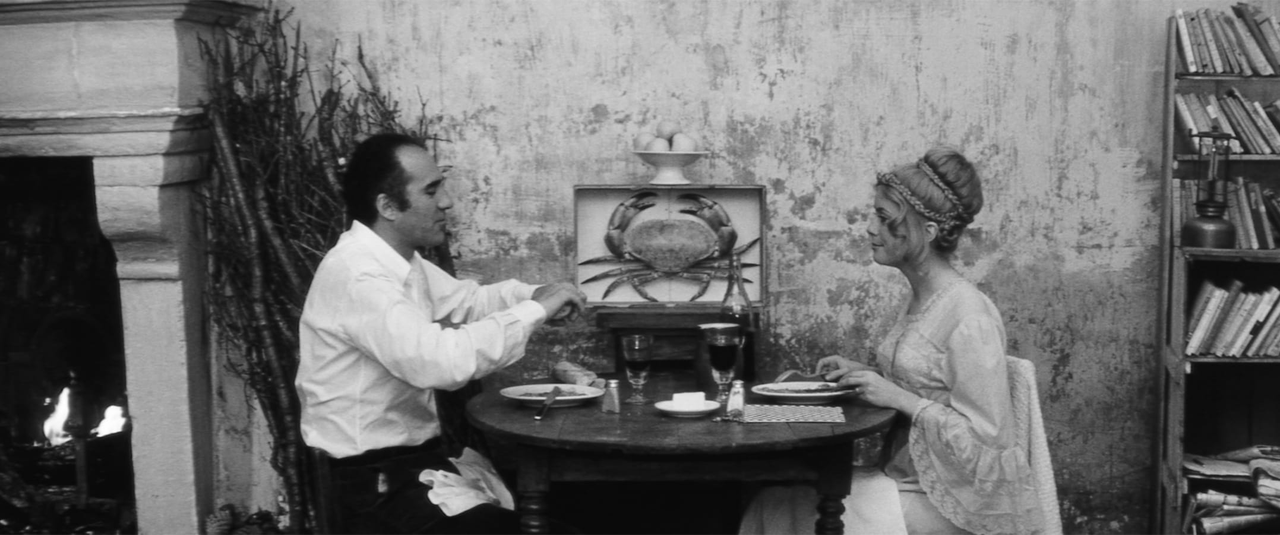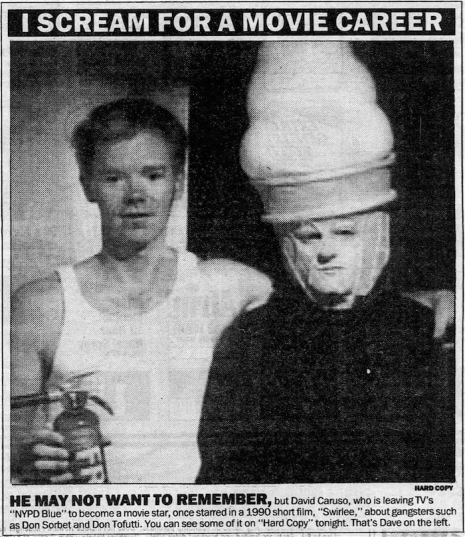“Bacchus gives us his blood so we may be born again.”Seconds (John Frankenheimer, 1966)
Nov
7
International Merlot Day

Nora (Salome Jens), seen from the back with her dress half unzipped, holds up a glass of red wine while kissing a reluctant Antiochus (Rock Hudson) during the ecstatic Bacchanal scene. DP: James Wong Howe.
At a bacchanalia, Rock Hudson's Antiochus Wilson finally strips down his hesitancy and realises he has a second chance at life, as a member of the new generation. To the Queen of wine! To Bacchus! To Pan!
Director of photography James Wong Howe's very controlled framing of the (initially censored) pre-Woodstock #Bacchanalian scene beautifully frames this pinnacle moment and proved almost too much for American censors.
scifi
– What's that?
– Tea.X the Unknown (Leslie Norman + Joseph Losey, 1956)
Oct
24
scoff

Two soldiers on nightshift ready to eat. One of them hands a mess tin with grub to the other when there's a sound. DP: Gerald Gibbs.
“Information is like a bank. Some of us are rich. Some of us are poor, with information. All of us can be rich. Our job, your job, is to rob the bank. To kill the guard. To go out there to destroy everybody who keeps, and hides, the whole information. Simple. Special. Information. Power.”Decoder (Muscha, 1984)
Sep
28
International Right To Know Day

In a crumbling bunker, the High Priest (Genesis P-Orridge) lectures about information. DP: Johanna Heer.
– The High Priest
Orlacs Hände [Die unheimlichen Hände des Doktor Orlac / The Hands of Orlac] (Robert Wiene, 1924)
Sep
25

Paul Orlac (Conrad Veidt) stretched out on a wooden bench in a tavern. A strange man sits on a second bench on the other side of the table. DPs: Hans Androschin & Günther Krampf.
– You boys care for a sandwich? Got tuna fish and minced ham on rye. – No, thanks. – It's nice and cold.The Monster That Challenged the World (Arnold Laven, 1957)
Sep
7
National Salami Day

Coroner Nate Brown (Byron Kane) offering two cops a couple of nice cold sandwiches straight from one of the morgue coolers on his lunch break. DP: Lester White.
Arnold Laven's The Monster That Challenged the World is one of the earliest, if not thé earliest, example of this peculiar movie and television trope: the coroner's lunch break.
Having some cold cuts over some cold cuts never gets old. Or appetising.
“You and I may dream of gold or grocery bills — but when a child slaps Morpheus on the back and says 'Hello, old man' — well it's a different story.”Moonland (William A. O'Connor, 1926)
Aug
15
Chant At The Moon Day

Mickey (Mickey McBan) and his dog looking up to the crescent moon from a perfectly round window with beaded curtains made of stars. Spot the Milky Way! DP: Edward Gheller.
A little boy and his dog are invited over by the Man in the Moon himself. The trip to the Moon is a big adventure for the drowsy duo and they meet peculiar flora, fauna and men along the way, lifted straight from the Great Moon Hoax.
– opening title card
Post-McCay's serial Little Nemo in Slumberland (1905) and pre-Fleming & Cukor's The Wizard of Oz (1939), William A. O'Connor is heavily indebted to both. Which doesn't make his short Art Deco-styled science fiction fantasy any less magical.
Les créatures [The Creatures] (Agnès Varda, 1966)
Aug
14

Edgar (Michel Piccoli) and Mylène (Catherine Deneuve) all dressed up for a home-cooked meal. On the wall behind them a huge framed mounted crab. DPs: Willy Kurant, William Lubtchansky & Jean Orjollet.
Swirlee (James Lorinz, 1989)
Jul
23
National Vanilla Ice Cream Day

Newspaper clipping. Mr Softy's roommate (David Caruso) and Mr Softy (James Lorinz), a man with a softee for/as a head, pose for a picture.
Ikarie XB 1 [Icarus XB 1] (Jindřich Polák, 1963)
Jul
20
Space Exploration Day

Two astronauts weightlessly pushing themselves through a round airlock. Their suits are eerily similar to the ones seen in Kubrick's 2001: A Space Odyssey (1968). DP: Jan Kališ.
Both anticapitalist and pre-Stanley space odyssey. Based on Stanislaw Lem's Obłok Magellana [The Magellanic Cloud] (1955).
“Yes, I'm afraid of death… but for a humble secret agent that's a fact of life, like whisky. And I've drunk that all my life.”Alphaville: Une étrange aventure de Lemmy Caution (Jean-Luc Godard, 1965)
Jul
16
petit déjeuner

In one of the very few daytime scenes, Natacha (Anna Karina) and Lemmy Caution (Eddie Constantine) share breakfast at a small table while awkwardly sitting on the armrests of two upholstered chairs. A large television is set up directly behind the table. DP: Raoul Coutard.
– Lemmy Caution